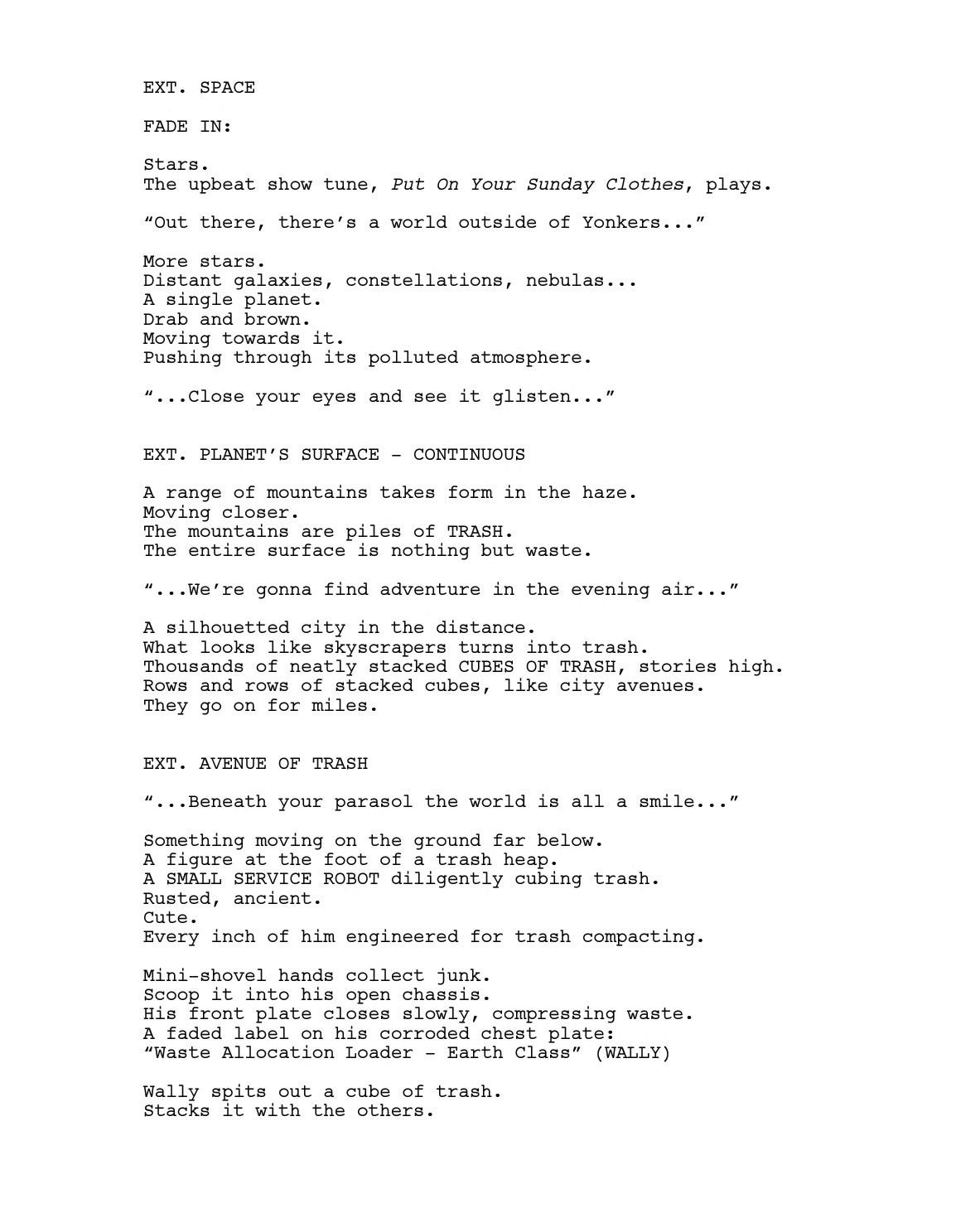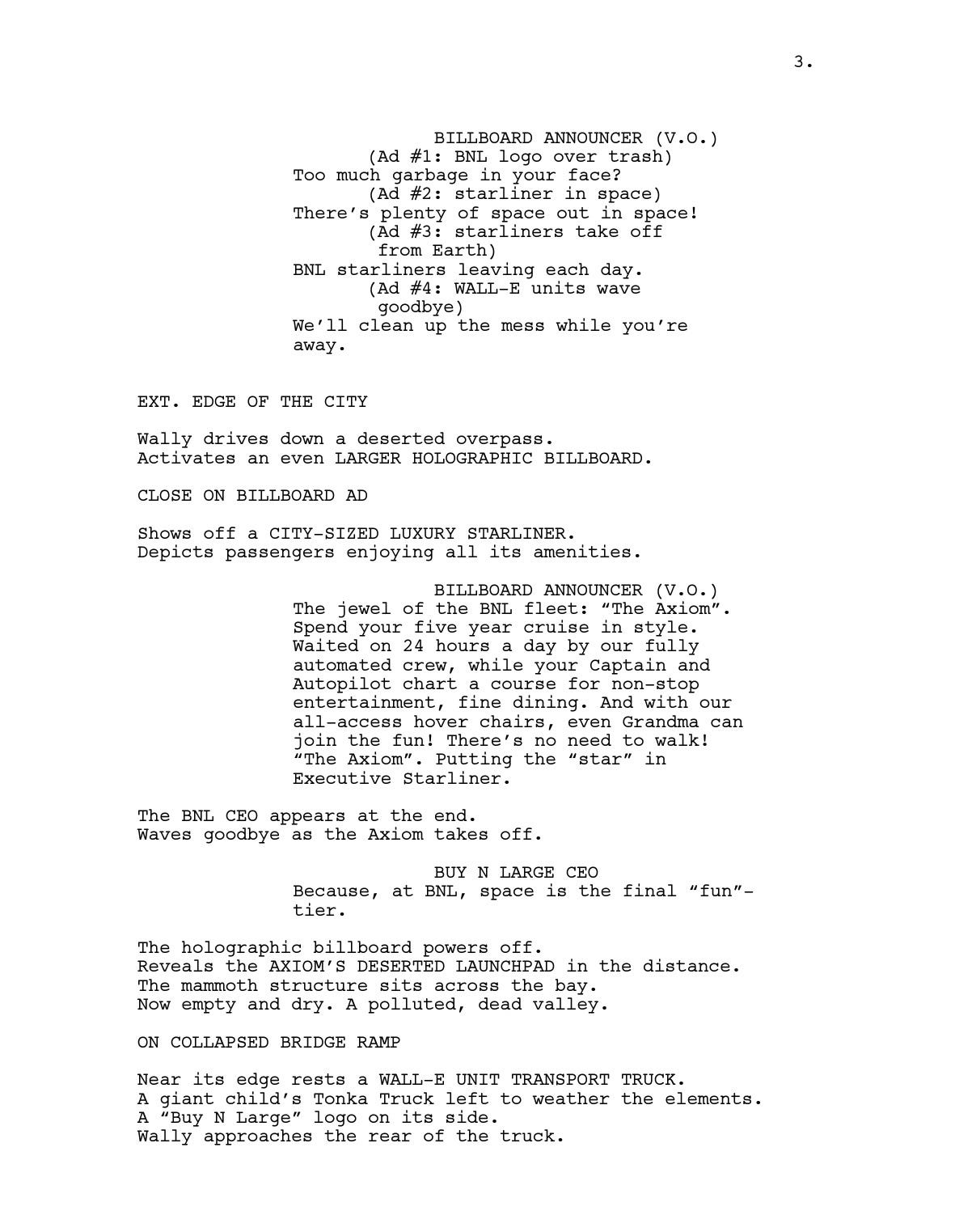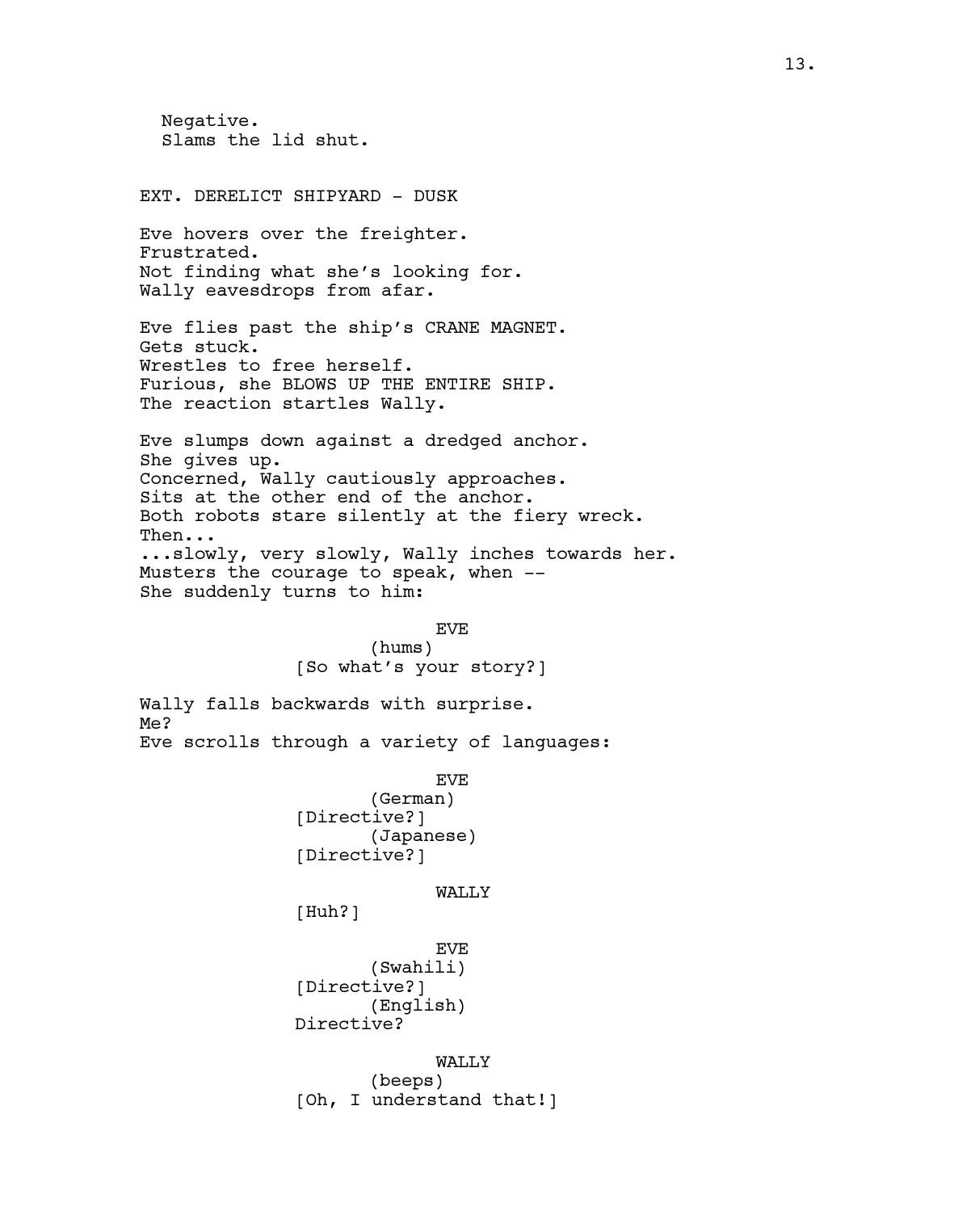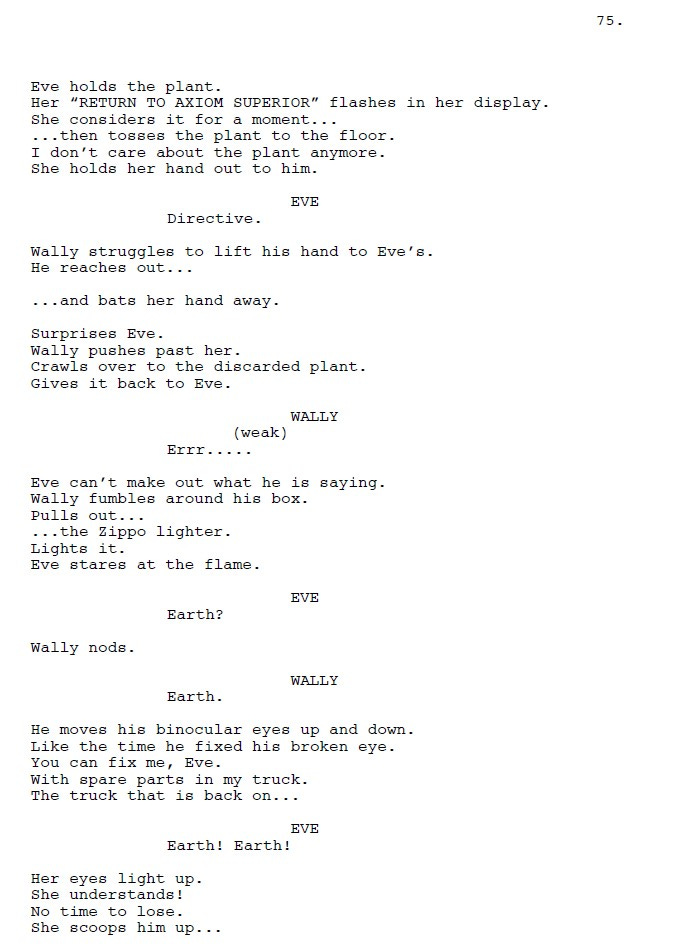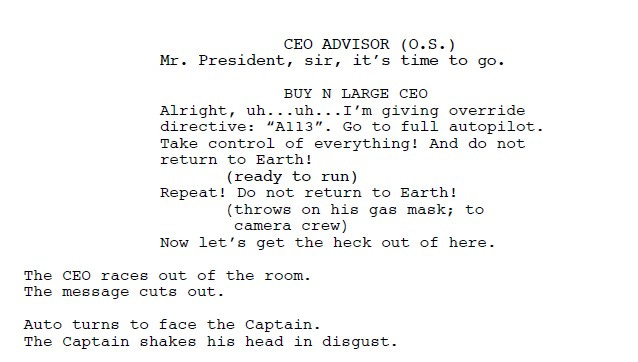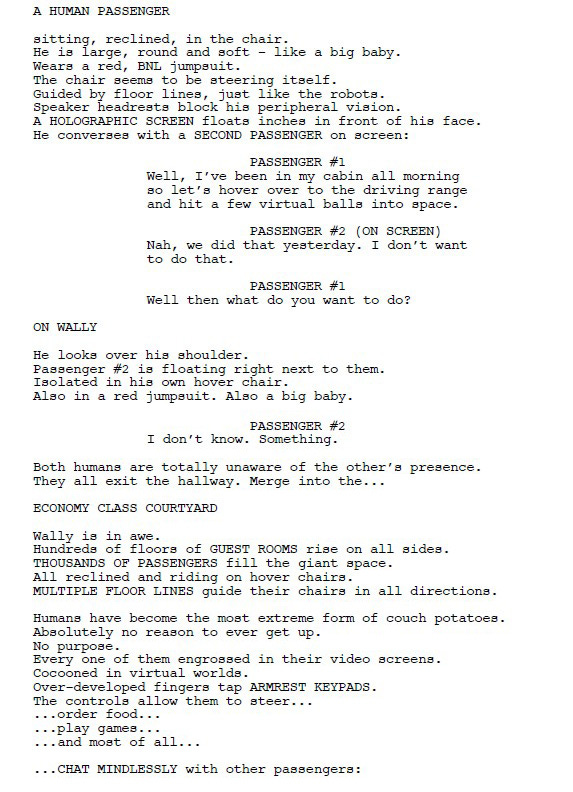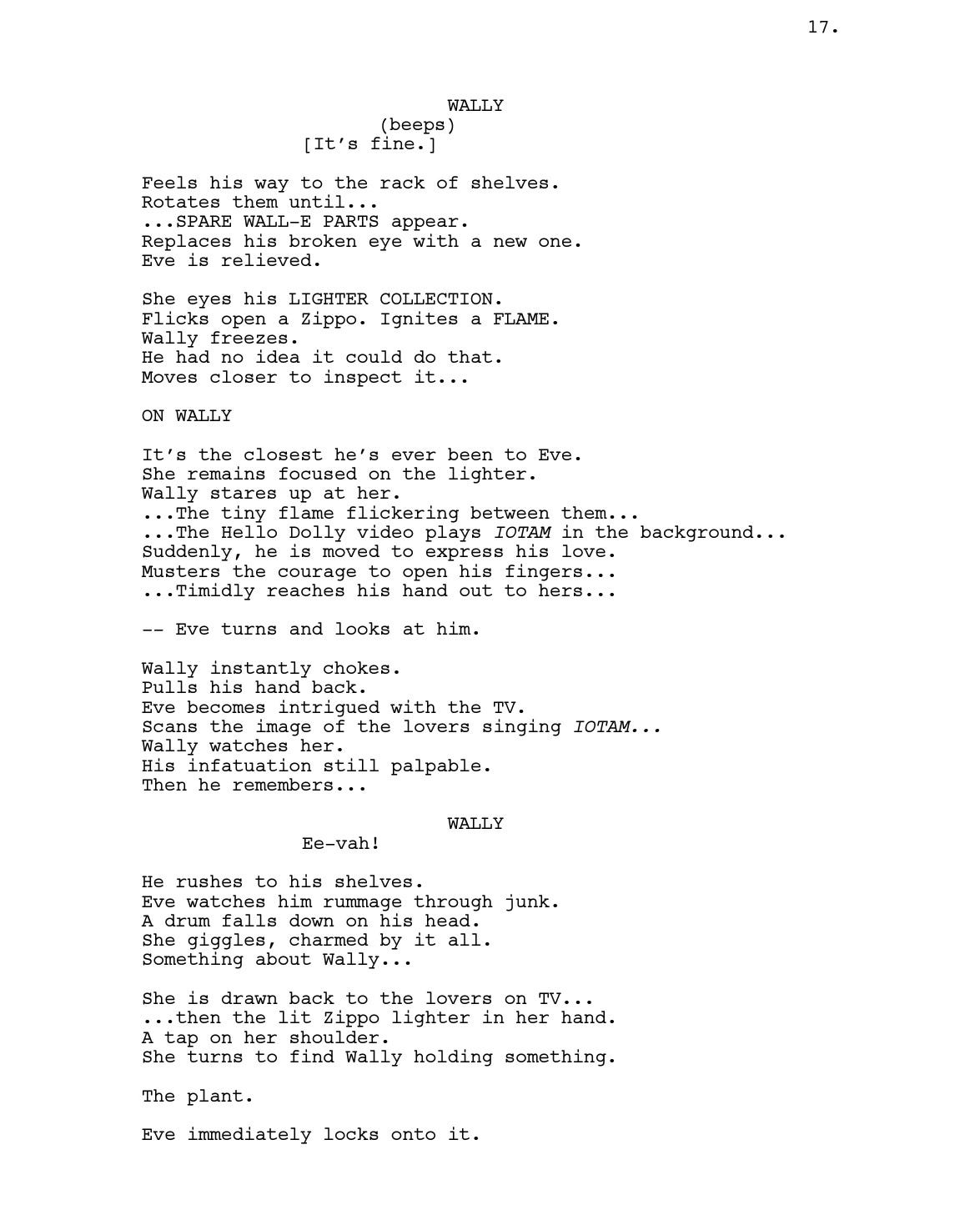WALL-E (2008) Script Review | #35 WGA 101 Greatest Scripts of the 21st Century
A funny kind of love story about a robot searching for love, nestled in a prescient cautionary tale about the dangers of pro-climate change and capitalism.
Logline: WALL-E, the last robot left on a deserted Earth, has spent over 700 years tidying up the planet, one piece of garbage at a time, while developing some interesting human-like qualities. When a ship arrives with the sleek EVE robot sent to scan the planet for signs of life, a smitten WALL-E embarks on a grand adventure when he follows EVE across the galaxy.
Written by: Andrew Stanton & Jim Reardon
Story by: Andrew Stanton & Pete Docter
Pages: 94
At lunch one day in 1994, a year before Toy Story put Pixar on the map, Andrew Stanton wondered, “What if mankind had to leave Earth and somebody forgot to turn the last robot off, and he didn’t know he could stop doing what he’s doing?”
The answer is that we’d get WALL-E, a transportive and affective story about a little robot on a quest to find love and, in the process, helps mankind to rekindle its humanity. It’s also perhaps the most challenging script to come out of Pixar in its second decade; the first 12 pages have no dialogue save in the form of advertisements providing exposition, and is largely action.
But it works. It is charming, and the final act is a heartstopper (perhaps a little too much); I guess what I’m trying to say is that WALL-E is a great example of how to write a great screenplay.
Wally (as spelt on the page) is the last robot on Earth. Humanity fled 700 years ago in a giant spaceship after every inch of surface of the planet was covered with garbage. But Wally continues to execute his duties every day, turning the garbage into compact blocks, a little bit at a time.
Somewhere along the way, Wally has picked up human-like qualities such as empathy (his only friend is a cockroach). In turn, he has become very lonely; all he wants is to hold hands with someone he loves. This goal is inspired by a scene from a VHS tape of the 1950s musical, Hello Dolly!
One day (or more precisely, on page 8), a ship lands on Earth. It deposits a probe droid called Eve. Unlike in Genesis, Eve is not created out of Wally’s rib-cage but she is the first woman that Wally meets. Needless to say, he’s smitten.
Why is Eve here? She’s on a mission to find if there are any signs of plant life on Earth. Coincidentally, shortly before her arrival, Wally did find a small plant growing inside a refrigerator. After a series of amusing scenes where Wally trails Eve and Eve grows frustrated by her lack of success, the two connect.
When Eve sees the plant, it triggers a protocol that shuts her down until the ship returns to collect her; a time during which Wally carefully and lovingly takes care of her…
… and a short time after, Wally hitches a ride into space and on to the Axiom when Eve is taken back to the ship, upon which the majority of the story is set. Wally’s desperation not to lose Eve, unintentionally, kickoff a chain reaction of events that include:
Helping two humans—John and Mary—connect;
Helping to free defected robots who become Wally’s allies;
Prompting the ship’s Captain to return back to Earth.
Of course, any good love story needs obstacles. In WALL-E, it’s the Autopilot of the Axiom. Unknown to the Captain, the Autopilot had been issued secret instructions centuries ago that it was not to allow humans to go back to Earth due to toxic levels making it uninhabitable. Wally and Eve’s efforts to give the plant to the Captain directly contradict the Autopilot’s directive; so he tries to get rid of them.
It is worth noting that even though Wally is the main character, the character journey belongs to Eve. See, although Wally is on a quest to find love— and does find it in the end— he remains the robot he was from the beginning. He is the pivotal character— instead, it is Eve who goes from caring about her directive (to deliver the plant) to caring about Wally, something that she shows in a touching scene on page 75.
Others, too, are changed by their contact with Wally— the Captain, John, Mary, the defective Axiom robots, and a cleaner bot named M-O.
Surprisingly for an animated film, WALL-E covers a lot of themes and ground about environmentalism, capitalism, and the dangers of ceding control to automated technology. The environmentalism angle is a no-brainer: over-consumption has literally overwhelmed the planet. Capitalism has run rampant, thanks to a mega-corporation known as BnL, whose CEO appears to be the American President or at least wields that much power— an ominous (and prescient) sign of the times we live in; especially when the richest man in the world, Elon Musk, is currently running rampant in the American government.
The automated technology might be the eeriest prediction of what happens when we allow technology to run our lives without checks and balances. Humans have become obese and use hover-chairs to move around, using virtual screens to talk to people who are right next to them! (Consider that WALL-E was written just before the iPhone, the first touch smartphone to hit the market, was released).
The Autopilot is an homage to HAL 9000 from 2001: A Space Odyssey; a warning that it is never a good idea to let a smarter system overtake human directives especially when it is rigidly following orders.
The WALL-E screenplay clocks in at a surprisingly short 94 pages. That is thanks to its sparse dialogue and its even shorter action lines; constrained single lines of four-to-eight words in homage to the spare prose style of writer Dan O’Bannon, famous for writing a little film called Alien.
The first 21 pages are a masterclass in setting up the principal characters, the world, the premise, and getting Wally to space in a short amount of time. We learn about Wally through the actions in the day of a life— he listens to music, collects interesting stuff; in a way, he is a blue-collar worker doing his job. We come to empathize with his plight.
But how do you create a believable love story between two robots that speak primarily in beeps? At least on the page? The answer is to write out the meaning of their words in square parentheses so that the reader can follow, and the sound designer (in this case, Ben Burtt) can use to create sound effects that convey the emotion.
In its early stages, the story started off as a comedy. But Stanton grew fascinated by the concept of loneliness; he wondered how that could play with a character like Wally. Eventually, he hit upon the realization that the opposite of loneliness is love; or “being with somebody.” For the story, that leap meant Wally would need to fall in love. The comedy turned into a love story, as the idea of one machine falling in love with another machine became integral to the writing. Stanton drew inspiration from science-fiction staples such as Star Wars, Alien, 2001: A Space Odyssey, Blade Runner, and Close Encounters of the Third Kind. Another influence was Robinson Crusoe.
But breakthroughs in thought don’t automatically yield to easy storytelling. Act 1 came to Stanton easily; the rest did not. Scrapped ideas included Eve being sent to prepare the planet for invasion and Wally leading a Spartacus-inspired rebellion against the gelatinous gibberish-speaking blobby invaders that turned out to be humans (a twist inspired by the original Planet of the Apes). It didn’t work; if anything, it created too many complications. Act 2 came together slowly and painfully. Even then, the story still had problems. For two years, the script climaxed with Eve getting shot in the heart battery and Wally giving her his. Another included Eve being electrocuted and Wally using a cigarette lighter to replace her power unit. Neither option worked (but the cigarette lighter remains in the final script as one of Wally’s curios).
It wasn’t until they flipped the scenario to have Wally shot and electrocuted, prompting Eve to save him instead, that the story came into focus. Suddenly, Eve’s journey became clearer, as she replaced the directive of the plant with the directive to save Wally. Much better!
Stanton was joined by Jim Reardon in scripting duties after Pete Docter (who has a Story By credit) moved on to other projects (namely, Up). Reardon, who had valuable experience as a story supervisor on The Simpsons, was Head of Story. Together, he and Stanton brought a new level of ambition and daring in both concept and execution.
It’s worth noting that Stanton taught himself to write screenplays after Pixar’s early experiences with Hollywood screenwriters were less than satisfactory. He closely studied The Art of Dramatic Writing by Lajos Egri and applied its teachings to his writing; I have read the book and can confirm that it is dead useful about learning the mechanics of writing (its focus is on theater but it could equally apply to film). One instruction is to clearly state the premise of your story to make it clearer; in WALL-E, the premise is absurdly simple: “Love conquers all programming.”
WALL-E is a call to scriptwriters to challenge themselves in their writing, whether in concept or execution. Write a script with bold ambition. Write a script with minimal dialogue. If you can do both in the same script, even better! Express the premise of your screenplay in one clear line. You may be surprised if the results pay off like a rocket on a successful launch.
Notes:
Disney | WALL-E Production Notes (Disney)
Robinson, Tasha (July 26, 2008)| Interviews: Andrew Stanton (A.V. Club)
Ebiri, Bilge (November 22, 2022)| Andrew Stanton Remembers When ‘Nobody Wanted to Make’ Wall-E (Vulture)
Friend, Tad (October 10, 2011) | Second Act Twist (The New Yorker)


